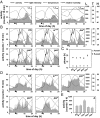Significance of activity peaks in fruit flies, Drosophila melanogaster, under seminatural conditions
- PMID: 23671102
- PMCID: PMC3670394
- DOI: 10.1073/pnas.1220960110
Significance of activity peaks in fruit flies, Drosophila melanogaster, under seminatural conditions
Abstract
Studies on circadian entrainment have traditionally been performed under controlled laboratory conditions. Although these studies have served the purpose of providing a broad framework for our understanding of regulation of rhythmic behaviors under cyclic conditions, they do not reveal how organisms keep time in nature. Although a few recent studies have attempted to address this, it is not yet clear which environmental factors regulate rhythmic behaviors in nature and how. Here, we report the results of our studies aimed at examining (i) whether and how changes in natural light affect activity/rest rhythm and (ii) what the functional significance of this rhythmic behavior might be. We found that wild-type strains of fruit flies, Drosophila melanogaster, display morning (M), afternoon (A), and evening (E) peaks of activity under seminatural conditions (SN), whereas under constant darkness in otherwise SN, they exhibited M and E peaks, and under constant light in SN, only the E peak occurred. Unlike the A peak, which requires exposure to bright light in the afternoon, light information is dispensable for the M and E peaks. Visual examination of behaviors suggests that the M peak is associated with courtship-related locomotor activity and the A peak is due to an artifact of the experimental protocol and largely circadian clock independent.
Keywords: afternoon peak; chronoethogram; circadian rhythms; courtship; period mutants.
Conflict of interest statement
The authors declare no conflict of interest.
Figures




Similar articles
-
Sympatric Drosophilid species melanogaster and ananassae differ in temporal patterns of activity.J Biol Rhythms. 2012 Oct;27(5):365-76. doi: 10.1177/0748730412458661. J Biol Rhythms. 2012. PMID: 23010659
-
Adult emergence rhythm of fruit flies Drosophila melanogaster under seminatural conditions.J Biol Rhythms. 2012 Aug;27(4):280-6. doi: 10.1177/0748730412448360. J Biol Rhythms. 2012. PMID: 22855572
-
Differential control of morning and evening components in the activity rhythm of Drosophila melanogaster--sex-specific differences suggest a different quality of activity.J Biol Rhythms. 2000 Apr;15(2):135-54. doi: 10.1177/074873040001500208. J Biol Rhythms. 2000. PMID: 10762032
-
Circadian regulation of egg-laying behavior in fruit flies Drosophila melanogaster.J Insect Physiol. 2006 Aug;52(8):779-85. doi: 10.1016/j.jinsphys.2006.05.001. Epub 2006 May 13. J Insect Physiol. 2006. PMID: 16781727 Review.
-
Egg-laying rhythm in Drosophila melanogaster.J Genet. 2008 Dec;87(5):495-504. doi: 10.1007/s12041-008-0072-9. J Genet. 2008. PMID: 19147938 Review.
Cited by
-
Behavior of the Avian Parasite Philornis downsi (Diptera: Muscidae) in and Near Host Nests in the Galapagos Islands.J Insect Behav. 2021;34(5-6):296-311. doi: 10.1007/s10905-021-09789-7. Epub 2021 Nov 17. J Insect Behav. 2021. PMID: 35153376 Free PMC article.
-
Perception of Daily Time: Insights from the Fruit Flies.Insects. 2021 Dec 21;13(1):3. doi: 10.3390/insects13010003. Insects. 2021. PMID: 35055846 Free PMC article. Review.
-
The Panopticon-Assessing the Effect of Starvation on Prolonged Fly Activity and Place Preference.Front Behav Neurosci. 2021 Mar 25;15:640146. doi: 10.3389/fnbeh.2021.640146. eCollection 2021. Front Behav Neurosci. 2021. PMID: 33841109 Free PMC article.
-
Do circadian genes and ambient temperature affect substrate-borne signalling during Drosophila courtship?Biol Open. 2015 Oct 30;4(11):1549-57. doi: 10.1242/bio.014332. Biol Open. 2015. PMID: 26519517 Free PMC article.
-
Natural conditions override differences in emergence rhythm among closely related drosophilids.PLoS One. 2013 Dec 11;8(12):e83048. doi: 10.1371/journal.pone.0083048. eCollection 2013. PLoS One. 2013. PMID: 24349430 Free PMC article.
References
-
- Saunders DS (2002) Insect Clocks (Elsevier, Amsterdam)
-
- Bhutani S (2009) Natural entrainment of the Drosophila melanogaster circadian clock. PhD thesis (University of Leicester, Leicester, UK)
-
- De J, Varma V, Sharma VK. Adult emergence rhythm of fruit flies Drosophila melanogaster under seminatural conditions. J Biol Rhythms. 2012;27(4):280–286. - PubMed
-
- Vanin S, et al. Unexpected features of Drosophila circadian behavioural rhythms under natural conditions. Nature. 2012;484(7394):371–375. - PubMed
-
- Menegazzi P, Yoshii T, Helfrich-Förster C. Laboratory versus nature: The two sides of the Drosophila circadian clock. J Biol Rhythms. 2012;27(6):433–442. - PubMed
Publication types
MeSH terms
LinkOut - more resources
Full Text Sources
Other Literature Sources
Molecular Biology Databases

